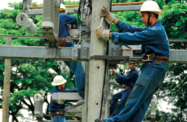Major energy projects in the Philippines are set to receive a substantial boost following changes to the approval system, with new reforms expected to dramatically speed up implementation.

On June 28 President Rodrigo Duterte signed an executive order establishing the Energy Investment Coordinating Council (EICC), a new body tasked with simplifying and streamlining the granting of licences and permits for large-scale investments.
The EICC aims to reduce approval times for major projects to 30 days, a sharp decrease from the current average of more than 3.5 years. The order also stipulates that if no decision on an application is made within 30 days, permits for the project must be automatically approved within five days.
The EICC will specifically deal with projects deemed to be of national significance. In order to qualify for the fast-tracked process, proposals must have a minimum capital investment of P3.5bn ($68.1m), demonstrate a significant contribution to the economy, and contain complex technical designs and processes.
Stakeholders have largely welcomed the move. “The sector needs a regulatory shake-up, and we look forward to the implementation of these directives, particularly as it has taken up to ten years for energy plants to be built in the past,” Frank Thiel, managing director of Quezon Power, told OBG.
New projects to meet growing electricity demand
The government hopes the reforms will spur investor confidence and expand the country’s capacity to meet growing electricity demand.
There is currently 7300 MW of power generation capacity either under way or approved for construction in the Philippines, according to BMI Research, with coal-fired plants leading the way as the major driver of energy growth.
With an electricity consumption growth rate of 10% last year, and further demand expected in the coming decade, the country is estimated to need 12,300 MW of additional generation capacity by 2030, according to the Department of Energy (DoE).
Temperature increases and efforts to combat the effects of the El Niño weather pattern are thought to be behind more robust demand growth, along with expansion of the middle class, which has seen more people move to urban centres.
New power projects are set to more than offset the growth in demand, however, as total installed capacity in the country grew by 14.2% in 2016, from 18,765 MW to 21,423 MW. Grid capacity in the Autonomous Region in Muslim Mindanao, meanwhile, grew by 31% over the same period – the fastest expansion of the country’s three grids.
The DoE expects the executive order to further support the rollout of new power projects, with more than 5000 MW of committed projects expected to come on-line by 2025.
Coal-fired plants to account for bulk of increased capacity
While the Philippines has immense renewable energy potential, the low cost of coal has led it to dominate present and future energy developments in the country.
Around 80% of the 7300 MW currently under approval or approved for construction will come from coal sources, which should see the fossil fuel reinforce its leading position in the country’s energy mix in the years to come. According to the most recent figures from the DoE, coal represents 47.7% of the Philippines’ power generation, followed by renewables (24.2%), natural gas (21.9%) and oil (6.2%).
Despite environmental concerns, coal-based plants are seen by the authorities as a cost-effective, as well as more dependable, means of power generation in the Philippines, and are therefore viewed as a key tool in alleviating power outages and strengthening energy security in certain parts of the country.
In Mindanao, for example, which has already seen rapid grid expansion, coal-fired capacity is on track to double over the next four years, with the construction of a number of new projects to generate more than 1000 MW of additional capacity.
However, the use of coal is set to result in a considerable increase in imports of the commodity, as new projects start to outpace the country’s coal production capacity.
The Philippines imported 20.8m tonnes of coal last year, a 47.8% increase on 2015, with this figure expected to rise by an additional 2m tonnes per year until 2020. In response to this demand, the DoE announced a new round of contracts for oil and coal prospecting areas in July.
New solar farm to boost renewable energy generation
Despite the proliferation of coal-fired power plants, there has been a parallel effort to expand the Philippines’ renewable energy capacity.
Work on the country’s largest solar power project – the 150-MW Solar Philippines-run photovoltaic park in the country’s Tarlac province – started in March. The $195m project will see the installation of 450,000 solar panels and an energy storage facility, making it one of the largest solar farms in South-east Asia, and is expected to fulfil the energy needs of the entire province.
Importantly, according to Leandro Leviste, president of Solar Philippines, the project represents the first in the country to be developed at a price point lower than a coal-fired plant.


